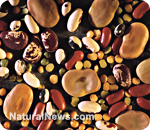Researchers testing promising, non-pharmaceutical Alzheimer's treatment
(NaturalNews) Researchers at Johns Hopkins University are carrying out clinical tests in which a pacemaker-like device is implanted into the brains of patients with early-stage Alzheimer's disease.
"We are very excited about the possibilities of this potentially new way to treat Alzheimer's," said lead researcher Constantine G. Lyketsos.

Alzheimer's is an incurable, degenerative disease that leads to progressive loss of cognitive function, including memory and the ability to perform simple daily tasks. An estimated 5.2 million people over the age of 64 currently suffer from Alzheimer's disease in the United States, and this number is project triple by 2050.
Although researchers have searched effective pharmaceutical treatments for years, none have yielded any promise. The new multi-center trial is designed to test a completely different model of treatment, in which electrical stimulation is delivered directly to the brain in order to slow and even reverse cognitive decline.
"Recent failures in Alzheimer's disease trials using drugs such as those designed to reduce the buildup of beta amyloid plaques in the brain have sharpened the need for alternative strategies," said Paul B. Rosenberg, director the Johns Hopkins University site for the study.
"This is a very different approach, whereby we are trying to enhance the function of the brain mechanically. It's a whole new avenue for potential treatment for a disease becoming all the more common with the aging of the population."
These "deep brain stimulation" devices have already been in use for 15 years in patients with Parkinson's disease, another neurodegenerative disorder. More than 80,000 people have received the implants, which appear to reduce the incidence of tremors and the need for medication. Other studies are underway to determine whether deep brain stimulation can effectively treat obsessive-compulsive disorders or depression.
In a preliminary study conducted in 2010, researchers found that patients with mild Alzheimer's disease who received the devices experienced sustained increases in glucose metabolism over a 13-month period, whereas the typical course of the disease is for glucose metabolism to decrease. Glucose metabolism is an indicator of nerve cell activity.
The new study will be conducted on 40 patients at five institutions across the United States and Canada. Half the participants will have their devices activated two weeks after surgery, while the other half will have their devices activated one year after surgery. The study is double-blind, meaning that neither doctors nor patients will know which group each participant is in.
The study is funded by the National Institute on Aging (part of the National Institutes of Health) and the medical device company Functional Neuromodulation Ltd.
Sources:
http://www.sciencedaily.com/releases/2012/12/121205102615.htm
Learn more: http://www.naturalnews.com/038510_Alzheimers_treatment_natural_remedies_brain_stimulation.html#ixzz2Gb7AXYlt
"We are very excited about the possibilities of this potentially new way to treat Alzheimer's," said lead researcher Constantine G. Lyketsos.

Alzheimer's is an incurable, degenerative disease that leads to progressive loss of cognitive function, including memory and the ability to perform simple daily tasks. An estimated 5.2 million people over the age of 64 currently suffer from Alzheimer's disease in the United States, and this number is project triple by 2050.
Although researchers have searched effective pharmaceutical treatments for years, none have yielded any promise. The new multi-center trial is designed to test a completely different model of treatment, in which electrical stimulation is delivered directly to the brain in order to slow and even reverse cognitive decline.
"Recent failures in Alzheimer's disease trials using drugs such as those designed to reduce the buildup of beta amyloid plaques in the brain have sharpened the need for alternative strategies," said Paul B. Rosenberg, director the Johns Hopkins University site for the study.
"This is a very different approach, whereby we are trying to enhance the function of the brain mechanically. It's a whole new avenue for potential treatment for a disease becoming all the more common with the aging of the population."
Deep brain stimulation
The device consists of a tiny, pacemaker-like stimulator that sends 130 electrical impulses per second through wires that are implanted in the brain's fornixes. The fornix is essential in transmitting information to the hippocampus, a structure believed to play an important role in memory synthesis and learning. In many early stage Alzheimer's patients, the first symptoms appear in the hippocampus. The electrical current is not detectable by the patient, Rosenberg said.These "deep brain stimulation" devices have already been in use for 15 years in patients with Parkinson's disease, another neurodegenerative disorder. More than 80,000 people have received the implants, which appear to reduce the incidence of tremors and the need for medication. Other studies are underway to determine whether deep brain stimulation can effectively treat obsessive-compulsive disorders or depression.
In a preliminary study conducted in 2010, researchers found that patients with mild Alzheimer's disease who received the devices experienced sustained increases in glucose metabolism over a 13-month period, whereas the typical course of the disease is for glucose metabolism to decrease. Glucose metabolism is an indicator of nerve cell activity.
The new study will be conducted on 40 patients at five institutions across the United States and Canada. Half the participants will have their devices activated two weeks after surgery, while the other half will have their devices activated one year after surgery. The study is double-blind, meaning that neither doctors nor patients will know which group each participant is in.
The study is funded by the National Institute on Aging (part of the National Institutes of Health) and the medical device company Functional Neuromodulation Ltd.
Sources:
http://www.sciencedaily.com/releases/2012/12/121205102615.htm
Learn more: http://www.naturalnews.com/038510_Alzheimers_treatment_natural_remedies_brain_stimulation.html#ixzz2Gb7AXYlt


